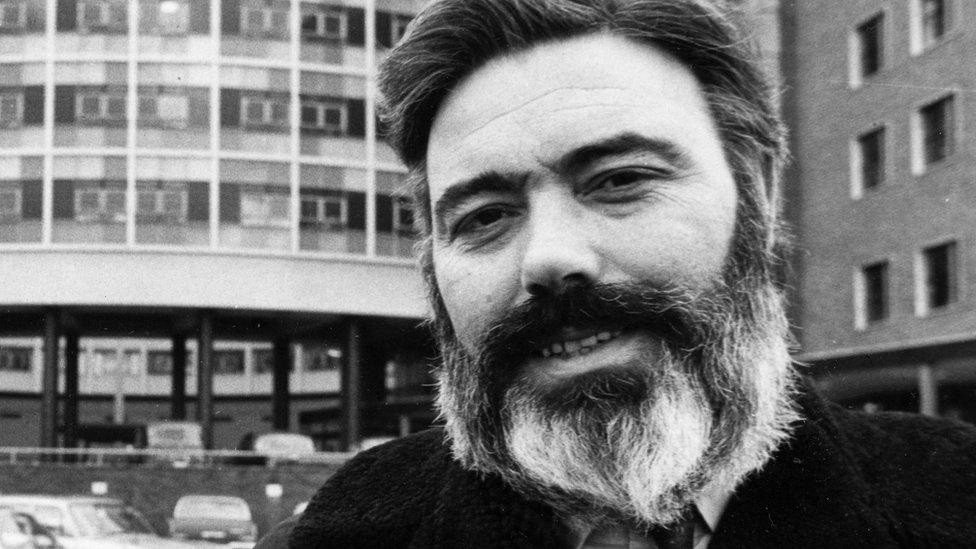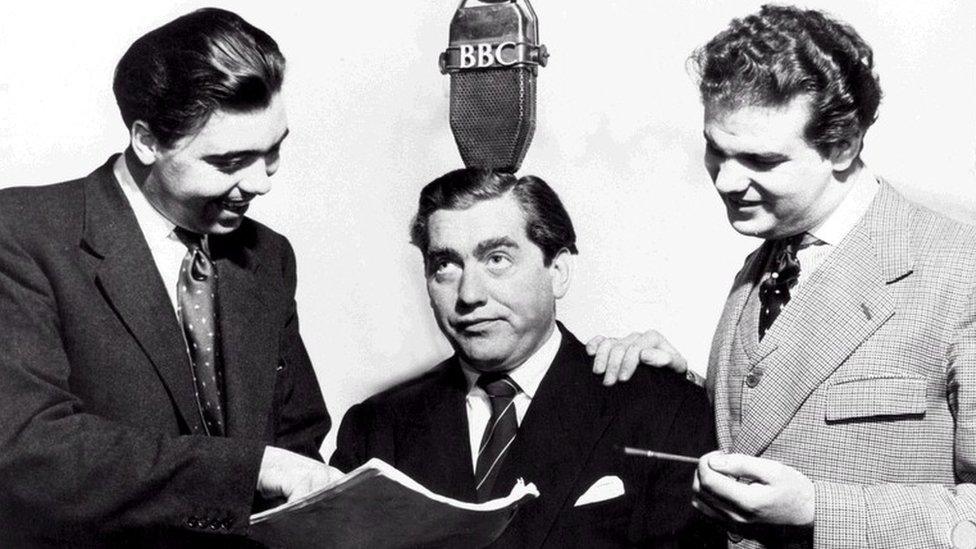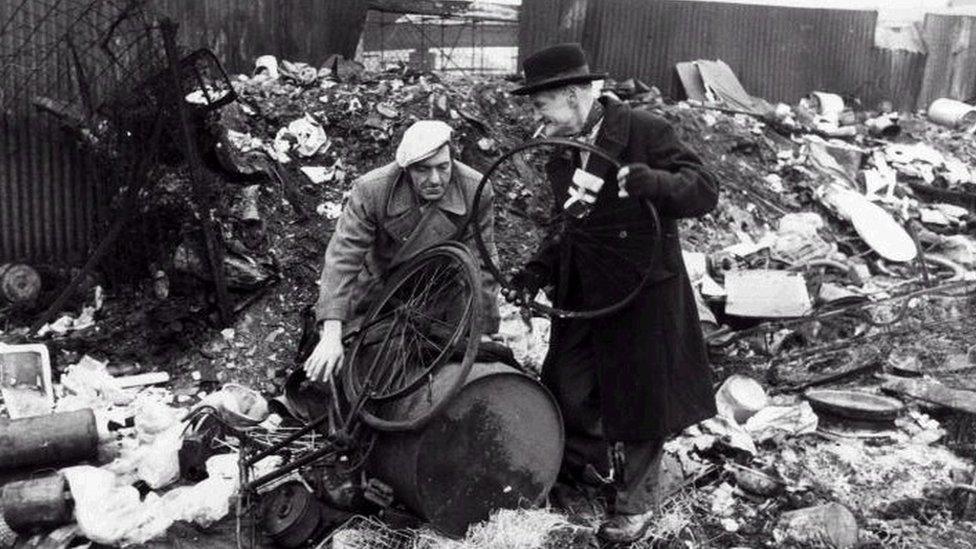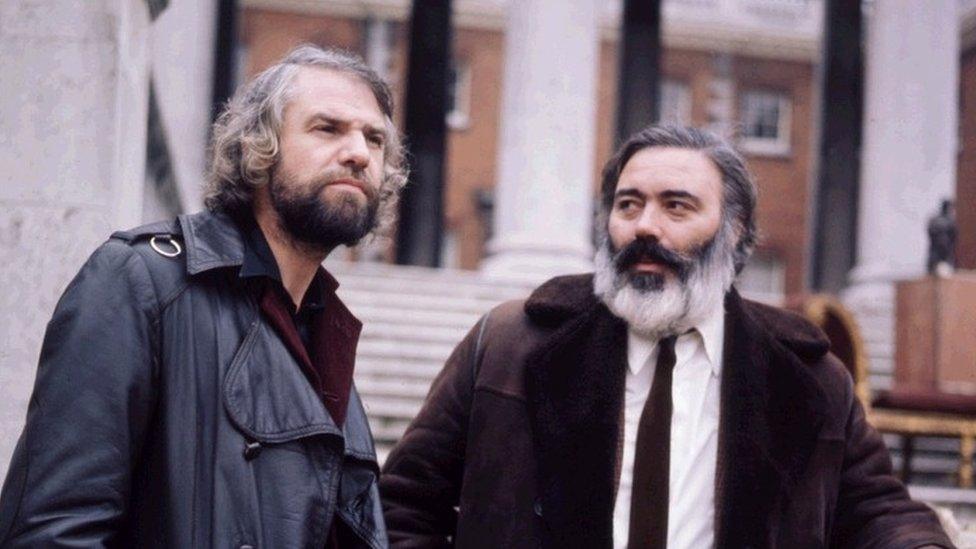Obituary: Alan Simpson
- Published

Alan Simpson outside BBC Television Centre in 1970
Alan Simpson formed, with Ray Galton, one of the great television scriptwriting partnerships.
Their early work with Tony Hancock pioneered what became known as situation comedy.
They went on to create Steptoe and Son, which became the most watched comedy on TV over its 12-year run.
But, although they continued to write, they failed to replicate the success of their early work.
Alan Simpson was born in Brixton, London on 27 November 1929.
After leaving school, he obtained a job as a shipping clerk before contracting tuberculosis. He became so ill that he was not expected to live and was given the last rites.
However, he survived, and while a patient in a sanatorium in Surrey he found himself alongside another teenage TB sufferer named Ray Galton.

Simpson (l) and Galton with Tony Hancock
Galton never forgot his first sight of his future partner, 6ft 4in tall with a build to match. "He was the biggest bloke I'd ever seen."
They discovered a shared love of American humorists such as Damon Runyon and had both listened to the BBC radio comedy programmes Take It From Here and The Goon Shows.
Their first work together was for hospital radio. Have You Ever Wondered was based on their experiences in the sanatorium, which was played out in 1949.
When Simpson left hospital he was asked by a local church concert party to write a show and he roped in Ray Galton to help. They also began sending one-liners to the BBC, which secured them a job writing for a struggling radio show called Happy-Go-Lucky.
New generation
The pair also linked up with several other promising new comedy writers and performers of the time, notably Eric Sykes, Peter Sellers, Frankie Howerd and Tony Hancock.
They were quickly tiring of the format of radio comedy shows of the time which included music, sketches and one-liners, and hankered after something with more depth.
They came up with the idea of comedy where all the humour came from the situations in which characters find themselves. Tony Hancock liked the idea and Hancock's Half Hour was born.

Steptoe and Son carried elements of black comedy and social realism
It is often credited as the first true radio sitcom, although two other shows of the time, A Life of Bliss and Life with the Lyons, were already using the format in 1954 when Hancock first aired.
Over the following five years the writers developed the format, often taking cues from a new generation of playwrights such as John Osborne and Harold Pinter.
The pace of each show became slow and more measured, in direct contrast to the speedy wise-cracking delivery of contemporary radio comedians such as Ted Ray.
Simpson himself appeared in early episodes as the unknown man who had to suffer Hancock's interminable monologues.
Clash
In 1956 the series transferred to TV and ran until 1961. The final series was just entitled Hancock and it was that run which featured the best-known shows including The Blood Donor ("It was either that or join the Young Conservatives") and The Radio Ham, in which Hancock proves completely incapable of responding to a distress signal from a sinking yachtsman.
Hancock, who was becoming increasingly self-critical and drinking heavily, sacked his writers in 1961. Unwilling to lose them, the BBC commissioned them to write scripts for Comedy Playhouse, a series of one-off sitcoms.
One play, entitled, The Offer, spawned Steptoe and Son, the tale of two rag-and-bone merchants, a father and son, living in Oil Drum Lane, Shepherd's Bush.

They remained close friends after their writing partnership ended
The script relied on the clash between the two characters; Albert, the grasping father with none too hygienic personal habits and Harold, his aspirational son who yearns for a better life but never achieves it. The show was unusual in that the two performers, Wilfrid Brambell and Harry H Corbett, were actors rather than comedians.
The original four series ran between 1962 and 1965 and the show was revived between 1970 and 1974, during which time two feature film versions were also released.
It proved to be the high point for the duo. There was further work with Frankie Howerd and, in 1977, Yorkshire TV attempted to replicate the success of Comedy Playhouse with Galton & Simpson's Playhouse, although none of the episodes produced a series.
Simpson quit writing in 1978 to pursue his other business interests although he and Galton remained close friends. In 1996 they reunited to update some of their best-known scripts for the comedian Paul Merton.
Simpson blamed their later lack of popularity on the fact that shows were commissioned by armies of managers rather than producers.
"Fifty years ago," he said in an interview with the Daily Telegraph, "if you had an idea, it could be going out in three weeks; the time it took to build the sets. Now it has to go through committees and the process takes years."

Follow us on Facebook, external, on Twitter @BBCNewsEnts, external, or on Instagram at bbcnewsents, external. If you have a story suggestion email entertainment.news@bbc.co.uk, external.